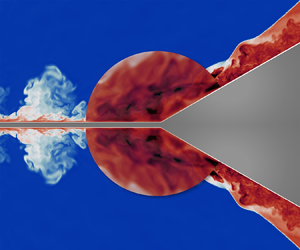Published online by Cambridge University Press: 18 November 2024

In hypersonic flight the shock wave and turbulent boundary layer interaction (STBLI) sharply increases wall heat transfer that intensifies the aerodynamic heating problems. In this work the STBLI is modelled by compression ramp flow with a Mach number of 5, a Reynolds number based on momentum thickness of 4652 and a wall to recovery temperature ratio of 0.5. The aerodynamic heat generation and transport mechanisms are investigated in the interaction based on theoretical analysis and direct numerical simulation (DNS) that agrees with previous studies. A prediction correlation of wall heat flux in STBLI is deduced theoretically and validated by some representative data including the present DNS, which improves the prediction accuracy and can be applied to a wider  $Ma$ range compared with the canonical Q-P theory. The correlation indicates that the sharp increase of wall heat transfer in the STBLI can be explained by the boundary layer compression and the convection transport enhancement. Based on the DNS results, the aerodynamic heat generation and transport mechanisms are revealed in the separation, recirculation and reattachment zones in the STBLI. From this perspective, the peak heat flux can be further explained by the enhancement of near-wall turbulent energy dissipation, compression aerodynamic heat generation and the near-wall turbulent transport. The generation and transport of compression aerodynamic heat reveal the underlying mechanism of the strong correlation between the peak heat flux ratios and the pressure ratios in STBLIs.
$Ma$ range compared with the canonical Q-P theory. The correlation indicates that the sharp increase of wall heat transfer in the STBLI can be explained by the boundary layer compression and the convection transport enhancement. Based on the DNS results, the aerodynamic heat generation and transport mechanisms are revealed in the separation, recirculation and reattachment zones in the STBLI. From this perspective, the peak heat flux can be further explained by the enhancement of near-wall turbulent energy dissipation, compression aerodynamic heat generation and the near-wall turbulent transport. The generation and transport of compression aerodynamic heat reveal the underlying mechanism of the strong correlation between the peak heat flux ratios and the pressure ratios in STBLIs.